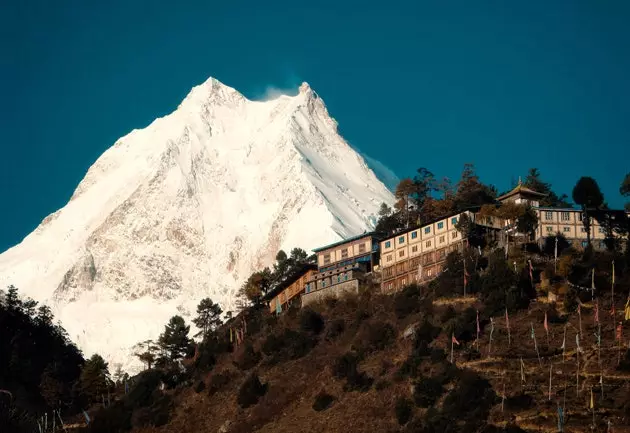
Tengboche Monastery with the Himalayas in the background
We fly over the Kathmandu valley and just before landing I can see it from a bird's eye view, with its oval bowl shape surrounded by mountains. It is easy to imagine that it was formerly submerged under the waters of a huge lake until, according to legend, Manjushri - a disciple of the Buddha - raised his sword of wisdom to create a pass between the mountains, thus draining all the water and leaving a fertile valley. This is just one of the many stories I will hear during my journey. Ancestral traditions, religious rites and beliefs of all kinds favor the magical and spiritual environment that breathes in Nepal and that attracts thousands of travelers.
But my first contact with the country is much more mundane. As I leave the airport, I am greeted by a breath of warm air and a horde of Nepalis vying for my attention – and my luggage – to take me to the hotel. My guide for the next ten days, Suresh , is waiting for me. As we travel the eight kilometers that separate the airport from the capital, he tells me in perfect Spanish that when he was young he was Sherpas , until he decided to set up his own company. The Sherpas, an ethnic group originally from the mountains of Nepal, played such an important role in the expeditions to the Himalayas that the word sherpa was left to refer to any guide and/or helper even if it is not of that ethnic group . This same valley has been since time immemorial a crossroads of the oldest civilizations of Asia. Tomorrow we will visit some of their more than 130 monuments declared a World Heritage Site by UNESCO , including several places of pilgrimage for Hindus and Buddhists.
But today I dedicate myself to strolling through the most cosmopolitan part of the capital, Thamel neighborhood. In the 60s its streets were filled with hippies who went in search of the origins of buddha and spiritual enlightenment . Only a couple of stores remain from that time in the freak street (the 'street of the weird', as they called the hippies) and a decrepit sign announcing the name. To buy a souvenir is the perfect place. Currently, those who come are curious travelers, and especially mountaineers who come to get equipped –at ridiculous prices– before starting one of their spectacular walks. The trekking in nepal has become one of the great attractions, and people from all over the world can enjoy the great landscape through picturesque villages at the foot of the Himalayas , with expeditions ranging from risky adventures at high altitudes to simple walks (for all tastes) .
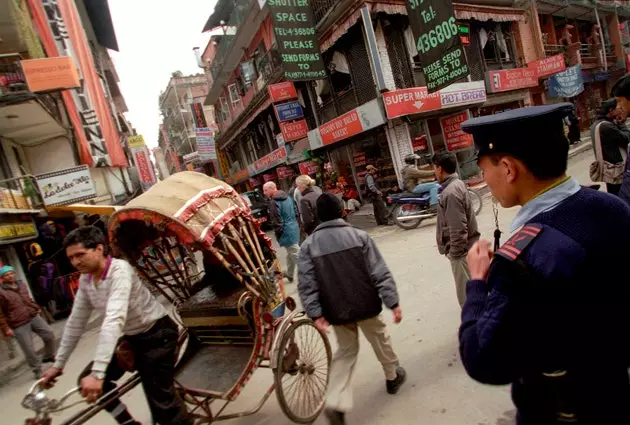
Thamel neighborhood in Nepal
On this occasion, I have not come to do trekking. But I am struck by the large number of foreign women traveling alone, which suggests to me that Nepal is quite safe. After strolling through bustling Thamel, Suresh leads me to the terrace of the Helena's restaurant , in which, in addition to a wonderful meal, we enjoyed an excellent view of the neighborhood. Even though night has already fallen, Thamel does not sleep. Today I will leave early, but tomorrow I will have dinner in one of the typical restaurants with live music that are so popular among travellers.
From the reign of the Malla dynasty, which ruled between the 12th century and the 18th century (Nepal's golden age), durbar square It has been the religious, political and social center of the city. And also where the newari art (which in Sanskrit means 'citizen of Nepal') has left its mark in a more notable way, with the delicate sculptures of the Hindu gods Krishna, Shiva, etc., as an emblem, earning the declaration, in 1979, of Patrimony of the Humanity along with its 60 historic buildings, including the Kasthamandap Giant Pagoda , from which the city takes its name. Its structure was built with the wood of a single tree and without using nails. I tell Suresh that I feel like I'm on a movie set. little buddha , and he tells me that I have a good eye, since it was here where some scenes were shot.
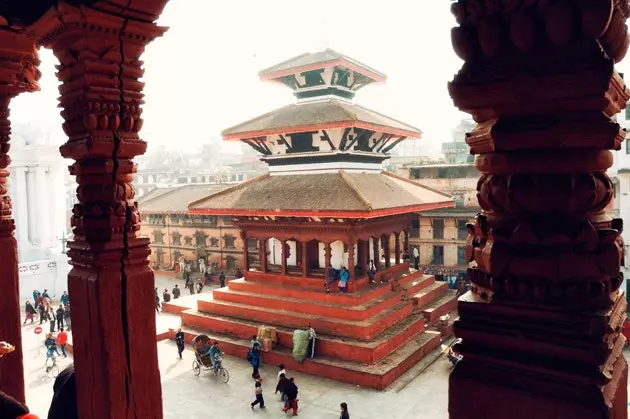
Trailokya Mohan Narayan Temple in Durbar Square
Among the many temples in the square, I am especially struck by the one in Kumari Chowk , the monastery where he lives the girl-goddess Kumari (in Sanskrit ku mari means 'easy die', which was the name that babies received in India). A Kumari is believed to be the reincarnation of the Hindu goddess Parvati Kumari (wife of Lord Shiva) until the girl starts menstruating. The little girl is chosen at a young age after undergoing ordeals and she is worshiped by both Hindus and Buddhists. She only comes out of her seclusion to be seen during big festivals, although, several times a day, she is shown through a small window. In one of those moments, I was lucky enough to see her dressed in red, but what I managed to see, rather, were some slanted eyes profusely painted with kohl. I suppose that Kumari would be imagining what life would be like out there, in the world of mortals, which she will soon discover.
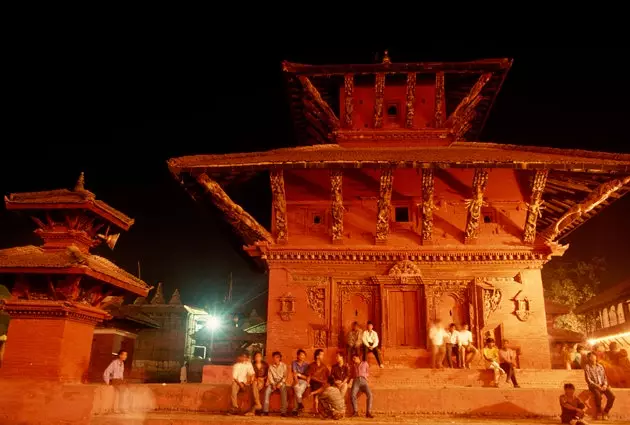
Kumari Chowk, the monastery of the girl-goddess
In the afternoon we visit Boudanath , the neighborhood where Tibetans fleeing the Chinese invasion settled in the 1950s and where the largest Buddhist stupa outside of Tibet is located. The temple was born at a crossroads in the middle of one of the trade routes between India and Tibet. Traders stopped here to pray. Those heading north requested Buddha's help in crossing the high passes of the Himalayas, and those traveling south thanked him after the hard trek through the mountains. Today it is still a meeting point for hundreds of pilgrims and monks who surround the stupa in a clockwise direction while spinning the prayer rollers. I find it reassuring to see them so focused singing the Om Mani Padme Hum , the best known mantra in Buddhism. Its syllables refer to the importance of practice and method in the path of the Buddha, whose eyes are drawn on the four sides of the stupa.
It's getting dark, but the flow of devotees does not stop . Today there is a full moon and on nights like this yak fat candles are lit around the temple. The show is moving. I watch him from a distance and still, the peace he radiates reaches me. The next morning we visited until the Swayambhunath stupa , better known as the monkey temple . It is a Buddhist temple located on top of a hill with impressive views over the valley. It is accessed by a steep path of 365 steps designed for pilgrims and the most daring travelers. Buddhist monks, sadhus – holy men – and, of course, mischievous monkeys who steal the food offered to the gods live here.
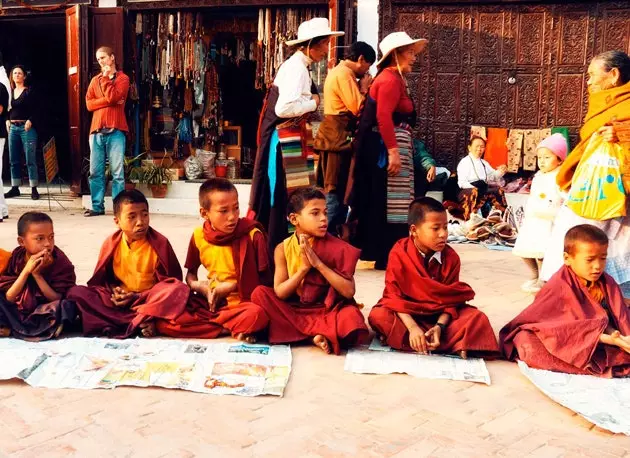
Buddhist monk boys at Boudanath stupa
Before returning to Kathmandu we stop at Pashupatinath, an immense complex dedicated to Shiva where the largest Hindu temple is located and also the most important in the valley, located on both banks of the sacred river. Bagmati. Hindus come here to purify themselves and to cremate their dead . Those of us who do not profess this religion are prohibited from entering the main temple, but the most interesting things take place outside its walls. A good number of sadhus are concentrated here.
They have apparently divested themselves of their material possessions to devote themselves to meditation, but they don't hesitate to ask me for money when I try to photograph them. Pashupatinath It gives me overwhelming images, like the cremation ritual . And other surprising ones: I am particularly struck by a woman with her young daughter who are dipping their feet in the river, indifferent to the fact that, just a couple of meters away, they are immersing the body of a deceased person in the water. . In this river life and death coexist, mixing naturally. A very different perspective than the one we Christians have.
Bungamati is a small town just nine kilometers from Kathmandu. It does not have many infrastructures – there are no restaurants or hotels – but Suresh convinces me to visit it for its authenticity and its rural atmosphere. Once he enters the village, the ganesha temple It is left to one side and you reach Durbar Square, surrounded by rustic houses next to which are mounds of grain that the women rake and spread on the ground to dry in the sun.
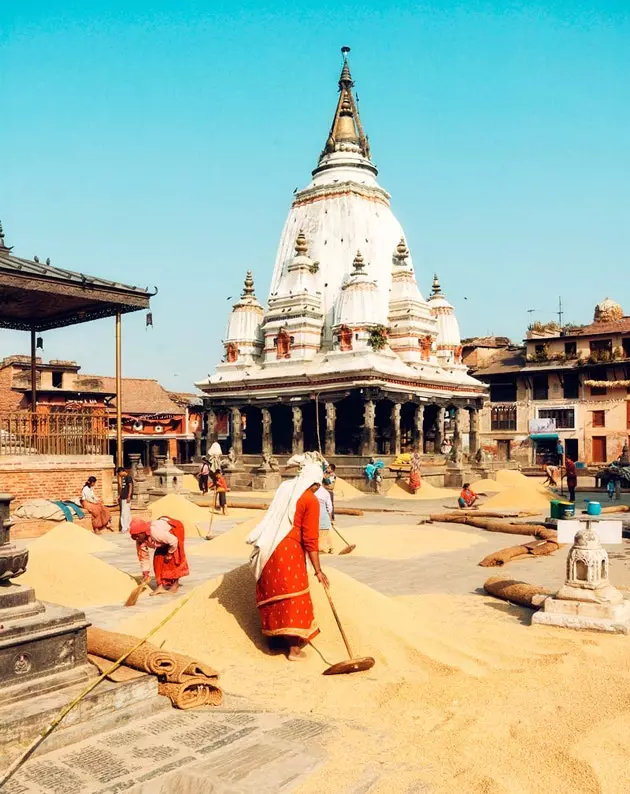
Bungamati, no hotels or restaurants
We arrived at what for me is the most beautiful city we will visit , Patan or Lalitpur, the city of craftsmen, home to the most famous wood carvers in Nepal. The technique they use is exactly the same as before. The absence of traffic allows me, apart from walking quietly, to hear the thuds of the chisels of the artisans who work in the street. The city has also kept its original essence with its narrow streets, red-brick houses and well-preserved Hindu temples, Buddhist monasteries and other monuments. Durbar Square and the surrounding architecture are a World Heritage Site, and it is here that Patan's pulse is measured. However, this one seems to me more authentic than any other. Perhaps because I meet snake charmers who show off their skills in front of groups of onlookers among whom I can't distinguish a single foreigner. Or for its friendly inhabitants, who give me sincere smiles when our eyes meet. Or because it never ceases to amaze me that one of the oldest Buddhist cities in the world , founded in the 3rd century B.C. still in such good condition . It seems that time has stopped.
Bhaktapur It is the third largest city in the Kathmandu Valley and also the third vertex of the UNESCO protected cities. Although there are only 14 kilometers that separate Bhaktapur from the capital, here life goes by in a very different way, as if time had stopped . The 'City of Devotees' (this is the meaning of its name in Sanskrit) politically and economically dominated the whole of Nepal for centuries, but since the Gorkha conquest in the late 1700s the city has been isolated from the outside world. It was reopened to Nepal just 50 years ago, when the road linking the city with the capital was built.
Of all the beautiful buildings that we find in Durbar Square between the 12th and 17th centuries, Suresh points out one in particular. It is Yaksheswor Mahadev temple , inspired by the Pashupatinath temple in Kathmandu but with one important difference: is decorated with erotic wood carvings . He tells me with a smile that these figures were sculpted to increase the birth rate, which at that time (it was the fifteenth century) was very low. They believed that if the faithful saw that the gods enjoyed sex they would do the same. The measure was a resounding success, although there was no way to stop it later. This city is arranged according to Newarí criteria, that is, **it is divided into different toles (neighborhoods) ** that are organized around a square with a well or a fountain and an altar. This is the meeting point for the neighbors when they go to get water or do their laundry. The life of the inhabitants continues its course with total normality without being bothered by the travelers who roam the streets. The floor of one of the dozens of squares I pass through is covered with hundreds of clay pots in the process of firing, from which a slight smoke rises under the impassive gaze of the potters.
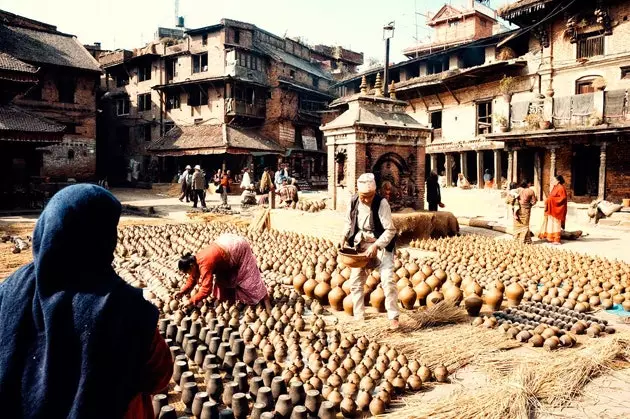
Vessel floor at Bhaktapur
It is unthinkable to travel to Nepal and not visit the town of Lumbini, a Terai village where the founder of Buddhism was born, Siddhartha Gautama (5th–4th century BC). People come to see the sacred garden where his mother gave birth and which, according to the scriptures, was on the way to the lost family clan capital, Kapilavastu. They also come to meet the Puskarny Pond , in which he bathed for the first time before becoming **buddha (the 'awakened one', the 'enlightened one') **. Declared a World Heritage Site by UNESCO in 1997, Lumbini is made up of a couple of dusty streets and a few adobe and straw houses. Of course, to be one of the great Buddhist pilgrimage centers, with more than 400,000 visits a year, it must be recognized that it has managed to maintain its original charm. One of the most beautiful images is that of the monks and faithful who, every day, they sit under the sacred bodhi tree –Where Buddha received enlightenment– to recite his prayers.
chitwan national park It is nestled in the lower Terai region, where the subtropical climate predominates. With an area of more than 900 km2, it is home to more than 50 types of mammals, some of them in danger of extinction, such as the Indian rhinoceros or Bengal tiger , while crocodiles and the so-called Ganges dolphins swim in its waters.
In order to get a close look at the elusive tiger, yes uresh recommends me to take a ride in the park on an elephant . In addition to providing an excellent vantage point, this animal knows when to stop if it detects danger (such as snakes lurking in the trees) . In the afternoon I try my luck again, this time by jeep, and, although I don't agree with the tiger, I have the pleasure of observing a rhinoceros. Our meeting lasts only a few seconds, but the emotion that I have felt having him so close lasts for the rest of the day.
Although for many it is usually the starting point – the best walks depart from here – Pokhara is the final destination of my trip, and the third largest city in Nepal, with almost 200,000 inhabitants. The city grew thanks to the commercial route that connected Tibet with India. But for those of us who haven't come to walk, this city is the ideal place to rest after the intensity of the trip , although Suresh has other plans for me: he has arranged a sunrise excursion for me where, he says, the views are spectacular. With the morning mist looming over us, we set off along a beautiful ascending path between rice fields. For half an hour we walk in silence as we watch the mist lift as the sun rises.
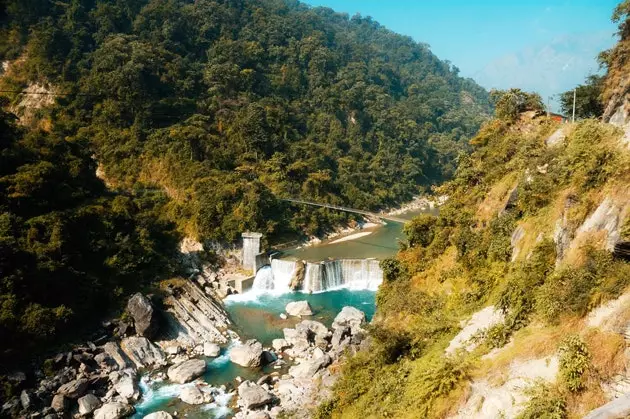
River in the Lumbini region
I like the sensation of peace that is breathed and I like even more the panoramic view that can be seen in our destination, Sarangkot lookout (at 1,592 meters altitude). We have been lucky, because we clearly see the Himalayas (in Sanskrit 'snow home' , hence for the local population those peaks that do not have snow on their top – which usually occurs below 3,500 meters – do not receive the name himälaya) . From the highest mountain range on Earth, with ten of the fourteen peaks over 8,000 meters high, including Everest (8,848 m), we can see some of its peaks: the Dhaulagiri (8,167 m), and the annapurnas (8,091 m), which in Sanskrit means 'goddess of the crops' . This set of five peaks are considered by mountaineers to be the most dangerous to climb on planet Earth.
After breakfast I am ready for the excursion to the phewa lake , the largest and most beautiful of the many in Pokhara. I rent a canoe and let myself be guided by its calm and dark waters. Sitting in this tiny little boat in the middle of the huge lake and with the giant snow-capped peaks of the Himalayas as a backdrop, I realize how small I am. In the center of the lake, there is a sacred temple, the Barahi, where hundreds of boats go (especially on Saturdays) to sacrifice birds in honor of a group of Newari goddesses.
During my last night in Nepal, I have dinner by the lake with some friends who have just arrived in Pokhara to start a trek. They are so excited that I want to accompany them. The meeting has motivated me to return again and get a little closer to the roof of the world.
* This article has been published in issue 62 of Condé Nast Traveler magazine
_ You may also be interested..._*
- Photographs of the Himalayan route: the adventure of Nepal
- Routes to spirituality
- All spiritual journeys
- Reflections from the top of the world
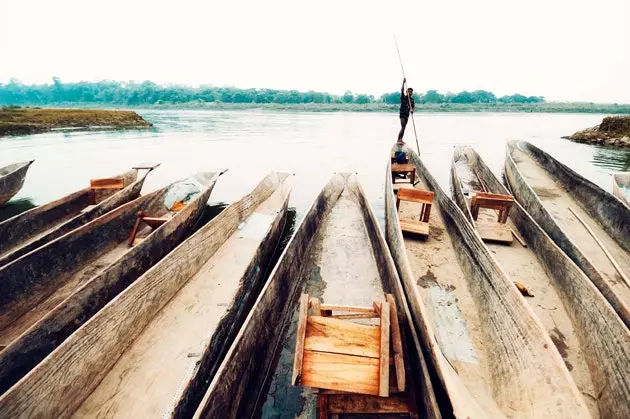
Chitwan National Park
